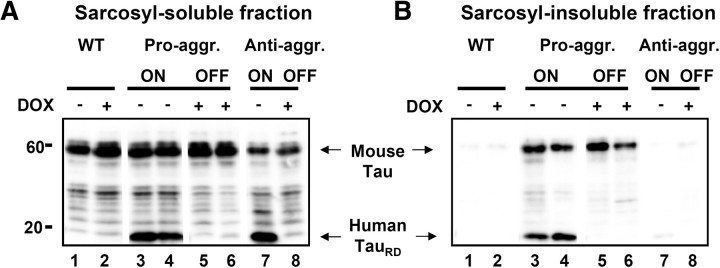Figure 4.
Analysis of soluble and aggregated Tau. Pro-aggregant or anti-aggregant TauRD were expressed continuously for 14 months (ON mice) or for 10 months plus 4 months off (OFF mice). The brain tissue of the mice was subjected to sarcosyl fractionation, and Tau was analyzed by blotting with antibody K9JA and compared with wild-type mice with or without doxycycline treatment. A, Sarcosyl-soluble fraction. B, Insoluble fraction. In both cases, lanes 1 and 2 show control mice without or with doxycycline treatment, lanes 3 and 4 represent mice switched on for 14 months, lanes 5 and 6 show mice switched on for 10 months and off for 4 months, and lanes 7 and 8 represent anti-aggregant mutant mice without and with doxycycline treatment. A, Lanes 3 and 4, At 14 months switch-on, the soluble fraction contains pro-aggregant TauRD, full-length mouse Tau, and some fragments. Lanes 5 and 6, After 10 months switch-on plus 4 months switch-off, the exogenous, pro-aggregant TauRD has disappeared, and only mouse Tau remains, partly fragmented. Note an approximately similar TauRD expression in anti-aggregant ON mice (lane 7) and no TauRD expression neither in wild-type (lanes 1 and 2) nor in anti-aggregant OFF (lane 8) mice. B, Lanes 3 and 4, At 14 months switch-on, the insoluble fraction of pro-aggregant ON mice contains both human TauRD and mouse Tau. In the pro-aggregant ON mice, the insoluble fraction contains ∼40% exogenous TauRD and ∼60% endogenous mouse Tau. After 10 months switch-on plus 4 months switch-off, the insoluble fraction contains no exogenous TauRD, and only mouse Tau remains (lanes 5 and 6). Note there is no detection of Tau aggregates in wild-type (lanes 1 and 2) and anti-aggregant ON and OFF (lanes 7 and 8) mice. Pro-aggr., Pro-aggregant; Anti-aggr., anti-aggregant; WT, wild type; DOX, doxycycline; −, without doxycycline; +, with doxycycline.

